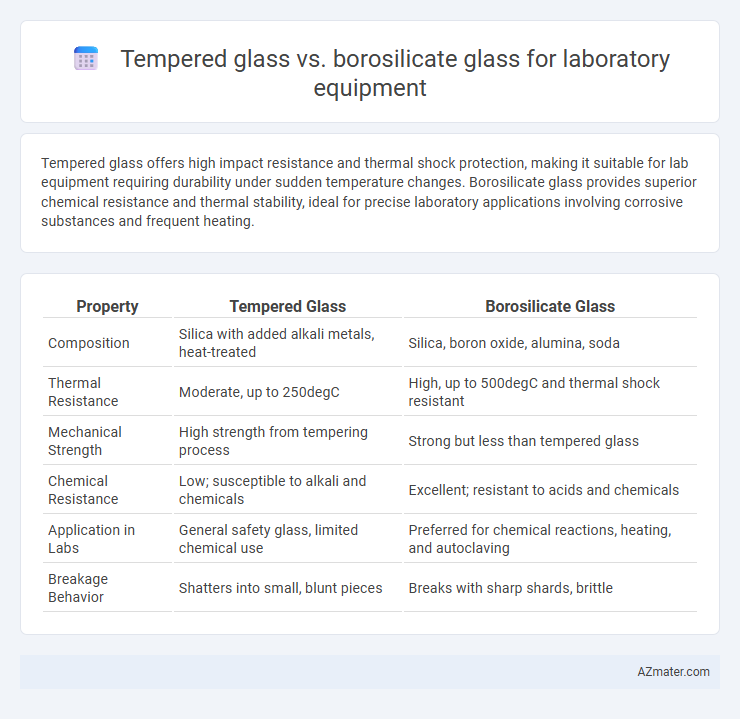Tempered glass offers high impact resistance and thermal shock protection, making it suitable for lab equipment requiring durability under sudden temperature changes. Borosilicate glass provides superior chemical resistance and thermal stability, ideal for precise laboratory applications involving corrosive substances and frequent heating.
Table of Comparison
| Property | Tempered Glass | Borosilicate Glass |
|---|---|---|
| Composition | Silica with added alkali metals, heat-treated | Silica, boron oxide, alumina, soda |
| Thermal Resistance | Moderate, up to 250degC | High, up to 500degC and thermal shock resistant |
| Mechanical Strength | High strength from tempering process | Strong but less than tempered glass |
| Chemical Resistance | Low; susceptible to alkali and chemicals | Excellent; resistant to acids and chemicals |
| Application in Labs | General safety glass, limited chemical use | Preferred for chemical reactions, heating, and autoclaving |
| Breakage Behavior | Shatters into small, blunt pieces | Breaks with sharp shards, brittle |
Introduction to Laboratory Glassware Materials
Laboratory glassware primarily consists of tempered glass and borosilicate glass, each known for distinct thermal and chemical properties. Borosilicate glass features low thermal expansion and high resistance to chemical corrosion, making it ideal for precise experiments requiring durability under rapid temperature changes. Tempered glass offers increased mechanical strength and is less prone to breakage from impact, but it has higher thermal expansion and is more susceptible to thermal shock compared to borosilicate glass.
Understanding Tempered Glass: Properties and Applications
Tempered glass, known for its enhanced strength and thermal resistance, undergoes a controlled thermal or chemical treatment to increase its durability, making it less prone to breakage compared to regular glass. This material is ideal for laboratory equipment exposed to rapid temperature changes or mechanical stress, providing safety through its ability to fracture into small, less harmful pieces. Its applications in lab settings include glassware like beakers and petri dishes, where durability and safety are crucial under intense experimental conditions.
What is Borosilicate Glass? Key Features and Benefits
Borosilicate glass is a type of laboratory glass known for its exceptional thermal resistance and chemical durability, composed primarily of silica and boron trioxide. Key features include high resistance to thermal shock, low coefficient of thermal expansion, and excellent clarity, making it ideal for precise scientific work. Benefits of borosilicate glass in laboratory equipment include enhanced safety under rapid temperature changes, resistance to chemical corrosion, and long-term durability compared to standard glass types like tempered glass.
Thermal Resistance: Borosilicate vs Tempered Glass
Borosilicate glass exhibits superior thermal resistance compared to tempered glass, with a low coefficient of thermal expansion (approximately 3.3 x 10^-6 /degC), allowing it to withstand rapid temperature changes without cracking. Tempered glass, while stronger in mechanical strength due to its heat treatment process, has a higher coefficient of thermal expansion and is more prone to thermal shock under sudden temperature fluctuations. Laboratory equipment made from borosilicate glass is preferred for heating applications and chemical reactions requiring precise thermal stability.
Chemical Durability: Which Glass Stands Up Better?
Borosilicate glass exhibits superior chemical durability compared to tempered glass, making it highly resistant to acids, bases, and solvents commonly used in laboratory settings. Its low coefficient of thermal expansion prevents stress fractures during rapid temperature changes, preserving its clarity and integrity under harsh chemical conditions. Tempered glass, while mechanically stronger, tends to be more susceptible to chemical corrosion and can degrade faster upon prolonged exposure to aggressive reagents.
Mechanical Strength and Safety Factors
Tempered glass offers high mechanical strength due to its thermal tempering process, making it resistant to impact and sudden temperature changes, ideal for handling stress in laboratory environments. Borosilicate glass, known for superior chemical resistance and thermal shock tolerance, exhibits lower mechanical strength compared to tempered glass but ensures greater safety by minimizing the risk of shattering into sharp fragments. In laboratory safety protocols, borosilicate glass's ability to withstand corrosive chemicals and thermal shocks often outweighs the mechanical advantages of tempered glass, making it the preferred choice for equipment requiring durability and secure handling.
Cost Comparison: Tempered Glass vs Borosilicate Glass
Tempered glass laboratory equipment typically costs less than borosilicate glass due to its simpler manufacturing process and lower raw material expense. Borosilicate glass, known for its superior thermal and chemical resistance, commands a higher price reflecting its durability and performance in harsh laboratory conditions. Choosing between the two depends on budget constraints and the specific application requirements where cost-effectiveness and material properties such as thermal shock resistance are critical factors.
Typical Laboratory Uses for Each Glass Type
Tempered glass is commonly used for laboratory equipment requiring high mechanical strength and resistance to thermal shock, such as glassware in chemical reactions and heating processes. Borosilicate glass is preferred for applications demanding superior chemical durability and thermal resistance, including distillation apparatus, volumetric flasks, and reflux condensers. The choice between tempered and borosilicate glass hinges on the specific laboratory use case, balancing factors like heat tolerance, chemical compatibility, and impact resistance.
Maintenance and Longevity Considerations
Tempered glass offers high resistance to thermal shock and mechanical stress, making it durable and easy to maintain with routine cleaning methods that prevent surface scratches. Borosilicate glass, known for its chemical inertness and superior thermal resistance, demands careful handling to avoid chips but provides exceptional longevity in corrosive environments and frequent temperature changes. Regular inspection and proper cleaning of both materials are essential to maximize lifespan, with borosilicate glass generally outperforming tempered glass in laboratory durability over extended use.
Choosing the Right Glass for Your Laboratory Needs
Tempered glass offers high impact resistance and thermal shock durability, making it suitable for applications requiring strength and safety in laboratory environments. Borosilicate glass features superior chemical resistance and thermal stability, ideal for handling corrosive substances and rapid temperature changes in experimental setups. Selecting the right glass depends on balancing factors like mechanical toughness, chemical compatibility, and thermal performance based on specific laboratory requirements.

Infographic: Tempered glass vs Borosilicate glass for Laboratory equipment
 azmater.com
azmater.com